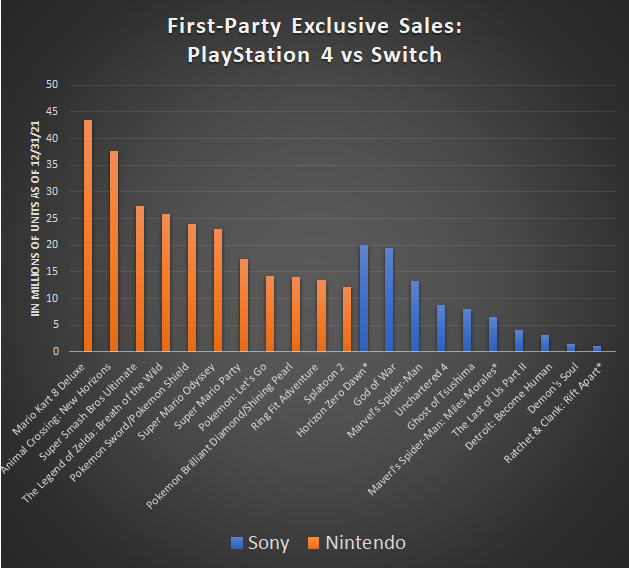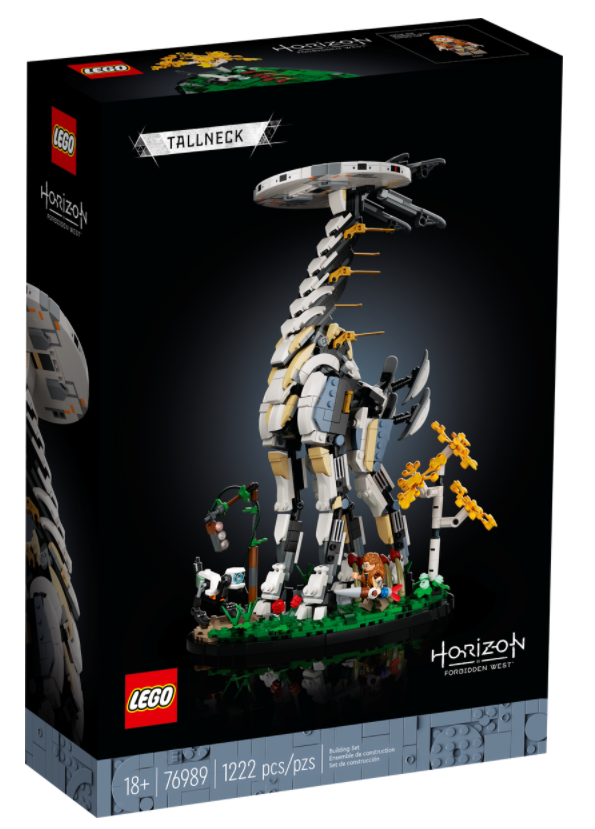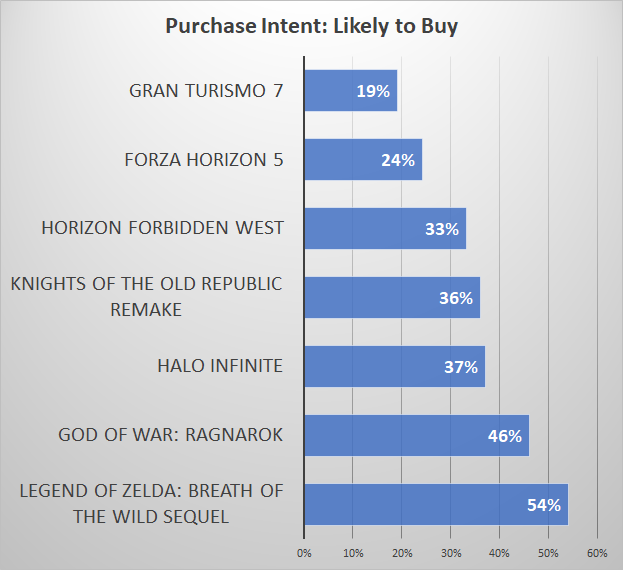On Friday February 18, PlayStation is seeing two major releases focused on its software brands. Sony Pictures is releasing the big budget action movie Uncharted based on the video game series. Horizon Forbidden West is the much-anticipated sequel to one of PlayStation 4’s best ever titles. These two products are a huge opportunity for PlayStation to promote its exclusive franchises which, historically, have been a challenge for Sony.
Sony Goes From Hardware to Software
Sony is, at heart, a Japanese consumer electronics company and has primarily focused on hardware. Since the 1980s the company has had an eye on diversifying expanding into other domains by buying a leading record company (CBS Records, now Sony Music Entertainment), movie and TV production (Columbia Records now Sony Pictures Entertainment) and a game division, today known as Sony Interactive Entertainment (SIE).
As the music and movie industries have lagged over the past few years, video games under SIE have been the big growth story. However, the synergy among Sony media properties has been limited and in DFC Intelligence’s opinion, the strategy of providing hardware, software and services has not really paid off. Another issue is that PlayStation marketing has lagged in promoting individual game franchises.
Sony has done a great job with game development in first-party PlayStation exclusives but has not successfully marketed its first-party titles as long-term franchises. SIE has overly focused on promoting PlayStation hardware, leaving third parties to promote the software side. With Microsoft buying up major game franchises, Sony clearly needs to up its game in software promotion.
Transmedia was a popular term over a decade ago. It centered on the idea that a given property can be provided across multiple media including games, movies, TV shows, merchandise etc. Transmedia is a proven concept but one that is not easy to execute. Uncharted the movie is shaping up as a major challenge for Sony.
Sony Interactive Entertainment released the first Naughty Dog Uncharted game back in 2007 for the PlayStation 3, followed by several sequels, the last being Uncharted 4 for PlayStation 4 in 2016. Development of an Uncharted movie started back in 2008 and it is arriving nearly six years after the game on which it was based, Uncharted 4: A Thief’s End was released. Last month SIE also quietly released some upgraded older Uncharted games for PlayStation 5, but like many video game to movie adaptions, the timing is not ideal.
Uncharted is a big budget movie featuring stars Tom Holland and Mark Wahlberg but is receiving lukewarm critical reception. The movie has a 47% rating on Metacritic and 40% on Rotten Tomatoes. Typical reviews can be summarized by Variety “a Video-Game Movie That’s Better Than Most of Them (but That’s Not Saying Much)” and RogerEbert.com “How is a movie based on a video game more soulless than the game itself?”
Given the mixed reviews and Sony’s past marketing mistakes, DFC does not believe the Uncharted movie will do a great deal to drive the franchise and especially so since an Uncharted 5 game release isn’t expected any time soon.
Sony’s Transmedia Focus
Nevertheless, movies and TV shows based on PlayStation games are a major Sony strategic focus. Uncharted was produced, in part, by PlayStation Productions, a division of SIE launched in 2019 specifically to adapt PlayStation games. An HBO TV show based on The Last of Us is scheduled for later this year. PlayStation properties Ghost of Tsushima, Twisted Metal and others are rumored to also be in production.
These transmedia productions are the sort of low hanging fruit Sony should have capitalized upon years ago. However, we point out that converting video games to movies have never been as successful as the reverse. Marvel’s Spider-Man game, released in 2017, is the second best-selling PlayStation 4 exclusive ever, and much of this was driven by the massive success of the Tom Holland/MCU movies at the time.
The Spider-Man video game highlights some of the issues of Sony’s hardware heritage. At 13.5 million units sold it was the highest selling Sony exclusive. However, it pales in comparison to Nintendo Switch’s exclusives which routinely sell over 20 or even 30 million units to a similar installed base.
While the Switch does not have as many third-party games as PlayStation, unlike PlayStation, Nintendo hardware sales are driven by the popularity of Nintendo created software. And as the number of AAA third-party releases continues to decline, PlayStation will be judged primarily by SIE created exclusives.
Nintendo is also a marketing juggernaut with significant market-oriented divisions. Nintendo of America exists to promote whatever new products that come out of Japan, both hardware and individual games to the US market. The same holds true for Nintendo of Europe.
DFC Intelligence has been somewhat critical of the hardware first strategy going back to the 2006 PlayStation 3 release when the core Cell processor was used as a linchpin of Sony’s consumer electronics strategy. The PlayStation 3 (and 4) was later used to promote 3DTV and Sony made a big venture into virtual reality with PlayStation VR. Unfortunately, 3DTV and VR did not take off as expected. Luckily, the PlayStation 4 made up the slack.
Sony’s hardware centric strategy has also come at the expense of individual game franchises which hurt not only the PlayStation 3 but portable Sony’s game systems PSP and Vita. And without major third-party support, Sony was not able to compete with Nintendo in portable hardware.
The good news is that Sony has a great deal of potential IP buried in the closet. For the few consumers that have been able to acquire a PlayStation 5, the included game for the system, Astro’s Playroom, highlights many classic PlayStation first-party titles going back 25 years.
Astro’s Playroom has “Easter Egg” references to many classic PlayStation products. This includes hardware driven successes like EyeToy and SingStar (both bigger hits in Europe) but also classic Sony developed games that in most cases have been dormant for years. Examples of classic Sony games found in Astro include Ape Escape, Heavy Rain, MediEvil, Jumpin! Flash, Gravity Rush, Detroit: Become Human, Sly Cooper, Jak and Daxter, PaRappa the Rapper, Ico, Shadow of the Colossus, Twisted Metal and more.
These franchises have the potential to see new life. Ironically two classic original PlayStation characters, Crash Bandicoot and Spyro the Dragon, were successfully relaunched recently by Activision Blizzard. Of course, they are no longer exclusive to PlayStation and may eventually be owned by Microsoft.
Last week it was reported that Uncharted director Ruben Fleischer is working on making a movie or TV adaption of the Jak and Daxter characters. Jak and Daxter is one of those obscure PlayStation franchises going back to the PlayStation 2. The last major installment was Jak 3 back in 2004.
To truly play the transmedia game, Sony will need to up its efforts beyond PlayStation Productions and the new Horizon Forbidden West video game could be a good start. The original Horizon Zero Dawn was one of the best games for the PlayStation 4. It launched in early 2017, around the same time as the Nintendo Switch.
In terms of quality and game play Horizon Zero Dawn was similar to the Nintendo Switch launch exclusive The Legend of Zelda: Breath of the Wild. Horizon was arguably better than Zelda and sold an impressive 10 million units in two years (SIE just announced that with a launch on PC that number is now 20 million). However, this was only about half of what Nintendo sold with Breath of the Wild in a similar time period.

What has fallen by the wayside in Sony’s hardware centric strategy is the promotion of individual game franchises. This really hurt not only the PlayStation 3 but portable Sony game systems PSP and Vita. Without major third-party support, Sony was not able to compete with Nintendo in portable hardware.
The good news is that Sony has a great deal of potential IP buried in the closet. For the few consumers that have been able to get their hands on a PlayStation 5, the included game for the system, Astro’s Playroom, highlights many classic PlayStation first-party titles going back 25 years.
Astro’s Playroom has “Easter Egg” references to many classic PlayStation products. This includes hardware driven successes like EyeToy and SingStar (both bigger hits in Europe) but also classic Sony developed games that in most cases have been dormant for years. Examples of classic Sony games found in Astro include Ape Escape, Heavy Rain, MediEvil, Jumpin! Flash, Gravity Rush, Detroit: Become Human, Sly Cooper, Jak and Daxter, PaRappa the Rapper, Ico, Shadow of the Colossus, Twisted Metal and more.
These are all franchises that have the potential to have a new life. Ironically two classic original PlayStation characters, Crash Bandicoot and Spyro the Dragon, were successfully relaunched recently by Activision Blizzard. Of course, they are no longer exclusive to PlayStation and may eventually be owned by Microsoft.
Last week it was reported that Uncharted director Ruben Fleischer is working on making a movie or TV adaption of the Jak and Daxter characters. Jak and Daxter is one of those obscure PlayStation franchises going back to the PlayStation 2. The last major installment was Jak 3 back in 2004.
To truly play the transmedia game, Sony will need to up its efforts beyond PlayStation Productions. The new Horizon Forbidden West video game could be a good start. The original Horizon Zero Dawn was one of the best games for the PlayStation 4. It launched in early 2017, around the same time as the Nintendo Switch.
In terms of quality and game play Horizon Zero Dawn was similar to the Nintendo Switch launch exclusive The Legend of Zelda: Breath of the Wild. Horizon was arguably better than Zelda and sold an impressive 10 million units in two years (SIE just announced that with a launch on PC that number is now 20 million). However, this was only about half of what Nintendo sold with Breath of the Wild in a similar time period.

Can Horizon Be Sony’s Zelda?
The hope is that Horizon Forbidden West lives up to its predecessor and there are signs Sony is thinking bigger in terms of promotion for the franchise. In May, Lego will release a set based on a character from Horizon Forbidden West.
Lego sets are an example of how transmedia is about much more than making a movie or TV show based on games. Nintendo and Microsoft both have Lego sets based on their properties. Lego had even planned some Overwatch sets but those were recently put on hold over concerns about Activision Blizzard’s workplace culture.
A Lego set is only one of many potential tie-in strategies. Nintendo has been a master at this with franchises like Pokemon which works across not only movies and TV shows but all kinds of physical merchandise including card and board games. Mario’s franchise has seen figurines, cartoons, clothing and extensive merchandising.
In short, PlayStation needs to up its transmedia game to compete going forward as both Nintendo and now Microsoft are significantly ahead in this regard. The good news though is that Sony seems to have finally realized the issue and has a great deal of undervalued and undervalued classic IP .
The PlayStation 5 remains the most desired system among console consumers and the time is ripe to extend that popularity to Sony exclusive software. Horizon Forbidden West could be the perfect start.

DFC Intelligence is your go to research partner for video gaming industry analysis. Our studies and Executive Briefs provide top shelf market analysis and forecasts of the video gaming market for customers throughout the video gaming landscape.
For more information on DFC Intelligence surveys and panels go here.
The latest DFC forecasts for console game hardware and software is available now.

